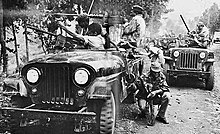Mercenaries and the Democratic Republic of the Congo
This article's tone or style may not reflect the encyclopedic tone used on Wikipedia. (June 2023) |
You can help expand this article with text translated from the corresponding article in Russian. (February 2023) Click [show] for important translation instructions.
|

Following the Democratic Republic of the Congo's independence in 1960, mercenaries from Europe, North America, and Southern Africa have been recruited to participate in various military conflicts within the country.
Background
[edit]Mercenary activity experienced a revival after the conclusion of the World Wars, which coincided with decolonization across Africa. As former colonies separated from European governments and transitioned into independent statehood, the existing colonial systems were dismantled. Consequently, the establishment of new national armies was necessary, and internal conflicts often arose in these transitional phases. To address these challenges, the governments of these newly independent countries often sought professional military personnel with combat experience.[1]
Legacy
[edit]In the 1960s, mercenaries in Africa were able to influence conflicts in favor of the governments employing them. These mercenary companies' experience was influential in the Angolan Civil War.[2][3]
The careers of many famous mercenaries of the 20th century began in the Congo. Modern ideas and stereotypes about mercenaries have been formed there.[1]
History
[edit]1960s
[edit]The Congo Crisis (1960–1965) was a period of turmoil in the First Republic of the Congo, one which began with independence from Belgium and ended when Joseph Mobutu seized power. Various factions employed mercenaries during this period, at times assisting the United Nations and other peacekeepers.
In 1960 and 1961, Mike Hoare worked as a mercenary commanding the English-speaking unit "4 Commando," which supported the breakaway state of Katanga under the leadership of Moïse Tshombe. Hoare chronicled his time in the country in his book The Road to Kalamata.
In 1964, then-Prime Minister of Congo Tshombe hired Major Hoare to lead a military unit called "5 Commando" made up of about 300 men, most of them from South Africa. The unit's mission was to fight a rebel group called Simbas, who already had captured almost two-thirds of the country.
In Operation Dragon Rouge, "5 Commando" worked in close cooperation with Belgian paratroopers, Cuban exile pilots, and CIA-hired mercenaries. The objective of Operation Dragon Rouge was to capture Stanleyville and save several hundred civilians (mostly Europeans and missionaries) who were hostages of the Simba rebels. The operation saved many lives;[4] however, it damaged the reputation of Moïse Tshombe as it saw the return of white mercenaries to the Congo soon after independence. This was a factor in Tshombe's loss of support from President of Congo Joseph Kasa-Vubu, who later dismissed him from his position.
During this period, Bob Denard commanded the French-speaking "6 Commando." "Black Jack" Schramme commanded "10 Commando," and William "Rip" Robertson commanded a company of anti-Castro Cuban exiles.[5]
Later, in 1966 and 1967, a group of former Tshombe mercenaries and Katangese gendarmes staged the Mercenaries' Mutinies.
1990s
[edit]In November—December 1996, with the direct participation of the French special services, the White Legion unit was formed. It was headed by Belgian Christian Tavernier. The formation joined the army of the Mobutu Sese Seko regime.
21st century
[edit]Since 2000, hired pilots from the former USSR have piloted Congolese Su-25s. Two planes with Ukrainian Mokratov (June 2007) and Belarusian Likhotkin (December 2006) were lost.[6]
In January 2017, Tutsi rebels shot down two Mi-24 helicopters with Georgian[7] and Belarusian[8] crews.
In popular culture
[edit]The 1966 Italian Mondo film Africa Addio documents a group of white mercenaries in the Congo fighting alongside the Congolese Army. In the film, the white mercenaries liberate the town of Boende in October 1964 from the Simba rebels. The film showed the execution of a Simba rebel by a white mercenary, which resulted in the film being temporarily seized by the Italian police. Its director, Gaultiero Jacopetti, was questioned by police on suspicion of producing a snuff film but was exonerated.[9]
References
[edit]- ^ a b Александр Гольц. Любой конфликт за ваши деньги // Вокруг света : журнал. — 30 сентября 2010.
- ^ Brogan, Patrick (1989), The Fighting Never Stopped, New York: Vintage Books, p. 6
- ^ Анна Полонская. Псы войны: как ЦРУ использовало наёмников для своих «грязных операций» // Life : сетевое издание. — 19 января 2017.
- ^ "Changing Guard". Time. 19 December 1965. Archived from the original on 30 September 2007. Retrieved 6 June 2007.
- ^ p. 85 Villafaña, Frank Cold war in the Congo: The Confrontation of Cuban military forces, 1960–1967 Transaction Books
- ^ Ремонт и модернизация штурмовиков Су-25 ДРК в Барановичах Archived 4 April 2019 at the Wayback Machine (30 октября 2018)
- ^ "ДР Конго был сбит вертолет Ми-24 с грузинским экипажем // Bazm.info, 30 января 2019". Archived from the original on 2020-09-19. Retrieved 2019-12-15.
- ^ Жизни троих белорусов, пострадавших при крушении МИ-24 в Конго, ничего не угрожает Archived 29 September 2021 at the Wayback Machine // СТВ, 1 февраля 2017.
- ^ Corliss, Richard (2011-08-21). "Provocateur Gualtiero Jacopetti Dead at 91: Honoring the Man Behind the Mondo Movies". Time. ISSN 0040-781X. Retrieved 2024-01-14.
Literature
[edit]- Коновалов, И.П. (2012). Африканские войны современности. Москва: Центр стратегической конъюнктуры. pp. 59–66. ISBN 978-5-906233-01-1.
- Коновалов, Иван Петрович. Солдаты удачи и воины корпораций : История современного наёмничества. — Пушкино : Центр стратегической конъюнктуры, 2015. — 216 с. — ББК 68:8 К64. — УДК 623(G). — ISBN 978-5-9906069-7-5.
